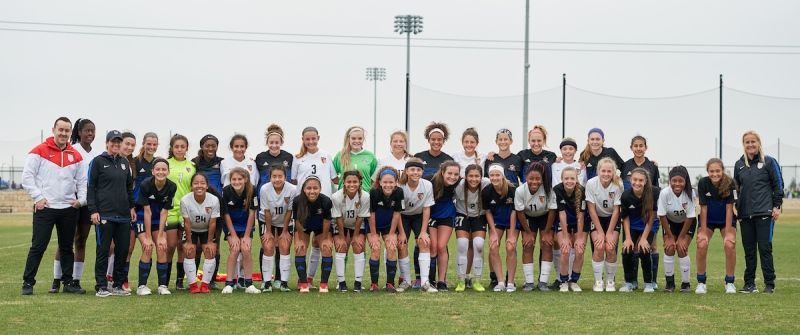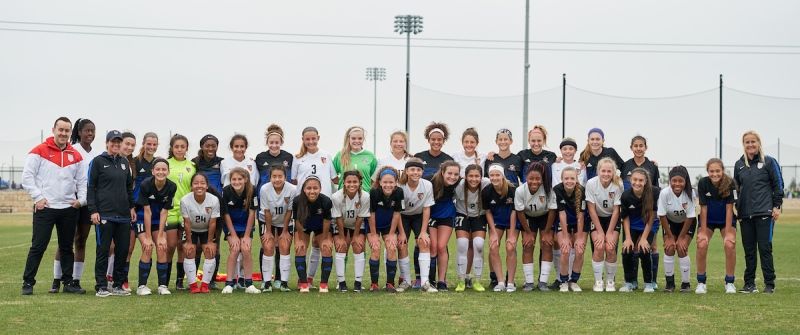For the first time in organized youth sports in the United States, eight U.S. Soccer Development Academy clubs fielding teams of players grouped by similar biological maturity, instead of chronological age, took the fields at Round Rock Multipurpose Complex in U.S. Soccer’s Bio-Banding Initiative kickoff event. The initiative, part of U.S. Soccer’s ongoing effort to develop world class players, coaches, and referees, was spearheaded by the federation’s High Performance department.
From April 21-22, the participating Development Academy clubs fielding both boys and girls bio-banded teams (Lonestar SC Academy, Solar Soccer Club, Dallas Texans and Houston Dash Youth Girls / Houston Dynamo Youth Boys) competed in two 80-minute games against normally familiar division rivals at their chronological age teams.
“This event was something that intrigued us as a club,” Lonestar SC Academy Director Victor Pace said. “We found it very interesting and very supportive. For us, on both ends of the scale, it was important that we looked at this to see how it could benefit us as a club. Especially in our younger ages, we've got a lot of late developers. The physical challenges our players face in our conference, which is very strong, are insurmountable in some games just because of the physical nature. So, this environment provided them with another opportunity or another avenue to see what they can do.”
With rosters of 16-18 players, each team was bio-banded by a five percent maturity range. For the four boys’ sides, that band was 91-96%, while the band on the girls’ side was 95-99%. Any player in the club’s pool of Academy players between U-13 (birth year 2005) to U-16 (birth year 2002), who’s current percentage to final maturity was between the five percent band, was eligible for roster selection. Of the 135 players falling in the bands and selected by their club to participate, 24 (18%) came from U-13 teams, 55 (41%) from U-14, 54 (40%) from U-15 and 2 (1%) from U-16.

To understand more about how percentage to physical maturity is calculated, watch the bio-banding animation video below.
The purpose and science behind bio-banding is to create a new, challenging environment for players that eliminates physical dominance and sees that players rely more on technical and tactical abilities. In allowing players to experience a bio-banded environment, the player development tool can help not only late maturing players, but also early maturers reach their highest potential as soccer players.
“Bio-banding benefits both the early and late maturing players,” U.S. Soccer High Performance Director James Bunce said. “The early maturer is the one that often gets overlooked as a beneficiary of the bio-banding concept. Early matures are the ones that are often dominating their age groups and while that might be perceived as really exciting and successful at the younger age groups, it's kind of like a false dawn and potentially a step back in their optimal development. When they get older and everyone’s maturity and physicality levels out, they can often drop out of the system because they’ve been over relying on their physical attributes as a youth player.
“Late maturers are more often the ones that drop out of the game, which is obviously really sad as there's a potential that we could be missing out on a world class player. We want to optimize everyone's participation in this amazing game and bio-banding allows late maturers to not be suppressed by the dominance of the physical players in their normal age groups. And then, once they do reach full maturity, those physical attributes will come with them and they will also have those technical and tactical skills that they likely relied on more heavily when they were younger.”
Throughout the weekend, Bunce, the high performance team, and other U.S. Soccer staff members on hand spoke with numerous parents and spectators. While a common stigma in the game is that playing up can be seen as a reward and playing down can have a negative connotation, parents in attendance learned more about and embraced the benefits of the initiative.
“I thought the teams were very well balanced,” Houston Dash Youth parent Rudy Hollenbach said. “Every player seemed to be at about the same level, physically, and that allowed the games to develop very evenly… We see it a lot (in the normal age groups), where a long ball is played forward and then the physically stronger girls can run by the defender and it becomes sort of this kick-and-rush game. Here, we didn't see any of that. It was very well balanced. The game was usually played out of the back… Girls that normally sometimes struggle a little bit, got more into the games. They really had a good opportunity to play well and play as part of the team. I think overall the team effort was much better because everyone got involved.”
Hollenbach was also quick to point out how important he feels bio-banding is to player development and the importance of spreading the education of the science.
“It's about looking at each individual player. And it's not necessarily all about winning. It's important, I completely understand, but I think the development aspect is more important. It's not based on whoever was the best when he or she was 13 or 14, but it's about getting to that 17-18 range, where all players are able to really blossom… I think it's a much more gradual development approach and that's really the key aspect. I think for a lot of parents it can be tough to understand. I'm hoping to help the process by educating people and helping explain why bio-banding is a good idea.”
Also in attendance were three of the world's top experts in child development and growth maturation, with over 2000 combined published scientific journal articles. Professor Robert Malina, Dr. Sean Cumming and Professor Alan Rogol each made their way to Round Rock, Texas, to help educate and answer questions from parents, coaches and players.
“For U.S. Soccer to put on this event and begin this initiative, I think it's a terrific idea,” Rogol said. “This is not something that is done once and that’s it. It's a work in progress. This is not going to change the game overnight, but it’s going to enhance it by getting more kids involved. The initiative will help teach later maturing kids skills that they will be able to take into later years of playing of sports, but not at the price of being run over when they're 12 or 13 or 14. And for early maturers, those physical advantages right now may not persist when they reach 16, 17, 18, and that's a very important message to teach. I can't see a downside of it!”
Amongst the U.S. Soccer technical staff in attendance for the weekend was Development Academy Director Jared Micklos and Development Academy Technical Directors Aloys Wijnker and Miriam Hickey. One connection between bio-banding and the Boys’ Development Academy is how the Academy already institutes a policy for late maturing players.
“For the 2017-18 season, the Development Academy leadership and technical group decided that we would institute a policy for late maturing players were clubs can select two players at U-16 and U-15 that can play down one age group,” U.S. Soccer Development Academy Director Jared Micklos said. “The Academy philosophy is about moving players up when they're ready, but we also thought that moving players down might be an opportunity for those players who aren't as physically matured to be able to have success at a younger age group. It's a club wide policy, so it's not team-based. After a player comes down, if they're having success, they can go back up and play with their natural, chronological age.”
“By no means does bio-banding replace the chronological age system. It is a useful, additional tool for coaches and staff to help create individual development plans as we, as a country, continue to strive to develop word-class players. Every player has a unique player pathway and we believe the education around the differences of physical maturity will go a long way in providing individually based environments for each player to thrive and develop.”
As U.S. Soccer continues to educate coaches, players, parents and fans on what bio-banding is and how the initiative can help provide meaningful opportunities for player development, educating clubs leaders that are at the forefront of player development marks the starting point for how the initiative will continue to flourish. By providing the tools and education to clubs who want to implement bio-banding into their everyday environments, the initiative will continue to grow and thrive across the landscape.
“In the end, everyone is coming together to create a pathway for every player,” Development Academy Boys’ Technical Directors Aloys Wijnker said. “There is not one pathway and everyone is doing the same thing. Soccer is a game. You're playing on a team. On the other hand, it's also a sport for individual players. Everyone has an individual development pathway and this is one tool that can help to create that pathway and give every player a better chance to become the best player they can be once they reach their final physical development.”


